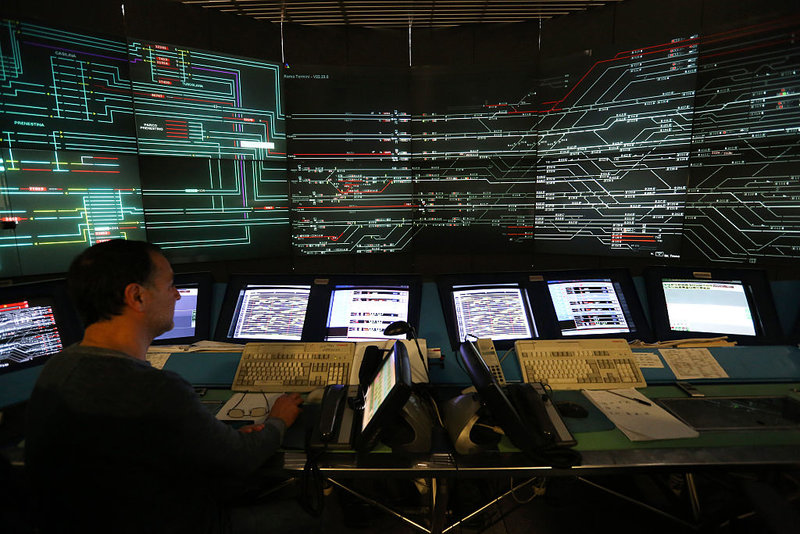Comment
Keeping on track: seamless control with IP KVM
Jamie Adkin, EMEA VP at Adder Technology, explains why implementing an IP KVM system in control rooms can be vital for efficient rail operations.

An employee works inside a Trenitalia SpA's high-speed trains control room at Termini railway station in Rome, Italy. Credit: Alessia Pierdomenico/Bloomberg/Getty Images
With billions of passengers and freight forwarders relying on rail daily, it has become one of the most used forms of transport. For each journey, passengers and freight must arrive at the destination in a timely and safe manner.
To ensure this, rail operators need to use the technologies available to them to optimise the network, while delivering on customer expectations.
The technology behind rail networks is highly complex. Teams of people in control rooms need to constantly monitor and analyse systems and the data they produce.
To do this effectively, they need computers and network infrastructure that deliver accurate and real-time video and data directly to the desktop from potentially thousands of data sources. This can only be done from a sophisticated and centralised centre of operations – the rail control room.
In the control room, it is crucial that operators can access and switch between these computers efficiently.
In the control room, it is crucial that operators can access and switch between these computers efficiently – enter Internet Protocol Keyboard Video and Mouse (IP KVM) solutions. This technology provides operators with the ability to transfer information without delay and in pixel-perfect clarity.
This is vital when operators need to access data in mission-critical situations, for example, when receiving data in real-time so they can respond and react in advance of a potential rail collision.
Understandably, the computing power demanded by these control rooms can be significant. The heat and noise from the hardware, coupled with the need for unwavering diligence and mental concentration can become unbearable for a rail operator.

Jamie Adkin, EMEA VP, Adder Technology
Mitigating data bottlenecks
Upholding good service quality and reliability in rail is increasingly tied to the sophistication of the technology used.
For example, control rooms utilise Supervisory Control and Data Acquisition (SCADA) software to visualise high-resolution digital video with real-time control. These applications make use of multi-display graphic cards to display the rail network across several monitors, ensuring nothing is missed.
This technology is critical when railway operators need to discern important signals and decipher key information in order to coordinate trains safely. This means having a proliferation of hardware, cabling, and power supplies so poor visual quality of data displayed on screens simply cannot occur.
By implementing IP KVM, rail operators are supported with purpose-built products to deliver high-quality data reliably and flexibly. Multi-tasking is the name of the game. Whilst large videowalls share an overview of a complete rail network, each operator needs to have vital information displayed directly to their workstation.
Whilst large videowalls share an overview of a complete rail network, each operator needs to have vital information displayed directly to their workstation.
IP KVM allows them to filter the wheat from the chaff and select data sources that align with their needs and preferences. Access is elevated to multiple computers through various displays from one workstation but controlled with just one keyboard and mouse.
For example, the Toluca-Mexico City commuter railway implemented an Adder high-performance IP KVM matrix to manage all I/O devices across a control room with 24 separate workstations.
This allowed each station to be delegated a specific function to monitor –such as traffic control, tunnel and station management, security coordination and crisis management.
Operators have full control over the number of active screens and the information sources they want to access. This is alongside a 28-screen multi-channel video wall for situational overview.
Customising delivery efficiently
Having a cost-effective and accessible solution is a key element of control room design. In fact, IP KVM can be integrated with existing infrastructure, requiring less cabling, and negating the need for scheduled downtime during maintenance.
Furthermore, it provides operators with the flexibility to scale up the system over time without major investment. In an increasingly data-intensive and digitalised world, the return on investment and cost reduction is clear.
From a customisation standpoint, there is no limit to the number of connected operators and computers. IP KVM allows for full scalability of operations, allowing flexibility according to developing needs – especially as the business operations change and grow.
Moving towards IP adds huge possibilities to improve workflow and infrastructure setup.
Moving towards IP adds huge possibilities to improve workflow and infrastructure setup. For instance, the individual configuration, handled by centralised software, allows computers to be made available for sharing and collaboration or limited to only being accessed securely by specific operators.
Rail networks have become increasingly reliant on hidden technologies like IP KVM. By working behind the scenes, they have facilitated centralised desktop positions and completely removed the need for noisy and disruptive physical computers.
The ergonomics have improved to create a clear, productive environment, conducive to making time-critical decisions. Operators can now focus on the work that matters and ensure safety and reliability across the networks.